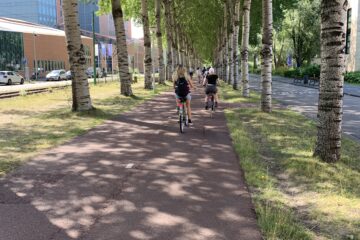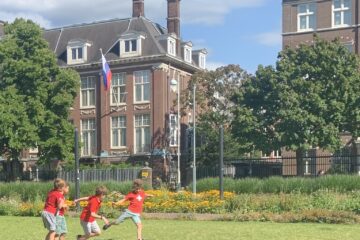We met with Chris Bruntlett who is the director of Marketing and Communications for the Dutch Cycling Embassy on Tuesday, July 12.
He works with several different organizations here that perform transportation research.
He wrote a couple of books, we’ll have to get some copies circulated – he is really an interesting person with lots of data to think about.
One interesting thing is that their website has case studies and some best practices highlighted. Check that out here.
Chris gave us a great presentation about transportation in the Netherlands. After World War II, the Netherlands was just like any other industrialized nation. They constructed many highways and created their cities around a transportation system devoted solely to transport in a car.
They demolished historical buildings to make way for new expressways.
They filled their ancient Roman canals to make place for highways.
They widened roads and intersections.
- Annual traffic fatalities for Netherlands (which is the size of Rhode Island) exceeded 3,000.
- And 400 of those were school children. Each year. Year after year.
Then the Oil Embargo hit them in the early 1970’s.
That is when they decided to develop a system that wasn’t so destructive to their families and would be more resilient to world fuel supply issues.
So they did start earlier than the rest of us to create a truly multi-modal system – but luckily for the rest of us they now have plenty of data to share.
They didn’t know where to start, or how to do it. So they experimented, studied, learned what worked and what didn’t.
Their early successes came only when they developed a network of protected bike facilities in one city – that connected everyone to where they wanted to go. They used not only all their arterials/collectors but local residential streets too. Honestly, the maps of this network look remarkably exactly like what the City of Bend just adopted in our 2019 TSP for its Low Stress Bicycling Network. They implemented the network in a little less than 10 years. They did re-construct some streets, and some intersections in that time frame, but most of their arterial and collector roadways were able to just be re-painted to make sure the bike facilities were wide enough and they added quick build protection to make them safe and comfortable and attractive to all ages and all abilities.
They relied heavily on their local, residential streets, which sounds a lot like our Neighborhood Greenways.. The difference? – they added quick build barriers and turn restrictions to eliminate the possibility of cut-through traffic. And they kept working on their local streets until the speeds and volumes were acceptable and comfortable for their elementary school children to safely use them to ride to school, and their elderly residents to safely use them to get to the grocery store and their friend’s houses.
So bike riding skyrocketed in this town – Women, Children, Elderly. They identified the 5 principles for why it worked:
- Direct
- Safe
- Comfortable
- Cohesive
- Attractive
They fixed key intersections that were difficult to use while walking or bicycling.
They reduced the likelihood of right hook crashes at intersections by slowing down right turns and placing their protected bike lane stop bar closer to the intersection so people riding were just that much more visible.
By devoting some minimal network space to separated bikeways on busy streets and creating quiet local streets, they have measured some great outcomes:
- congestion has decreased, intersections remain under capacity so they don’t wait for more than one traffic signal cycle to get through, and safety has improved. There are fewer crashes, fewer injury crashes, fewer fatalities. Surveys of residents consistently show that driving remains comfortable.
- neighborhoods are protected from speeding cars
- more space within their community can be devoted to parks, playgrounds, & plazas.
- health improves (some small amounts of cardio are actually good for us)
And people here don’t ride a bike all that far.
- roughly 1/3 of all trips are by bike
- on average, those that do ride their bikes, ride just 2 miles each day.



1 Comment
David Green · July 21, 2022 at 2:31 am
It sounds like a pattern we could use. Protected bike lanes using quick build sounds just right for Bend.